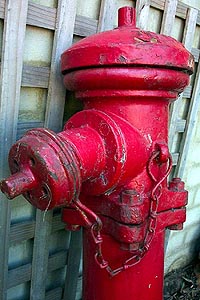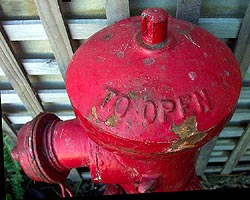
|
 |
Click Images to Enlarge  |
|
2201 Nozzles: 1x 65mm? © 2004 Geoff Fraser |
2201c © 2004 Geoff Fraser |
2201b © 2004 Geoff Fraser |
|
Melbourne spec wet barrel hydrant Melbourne and Metropolitan Board of Works - Melbourne, Australia "These hydrants were very common in Australia especially in Melbourne. They are wet-barrel hydrants and may also be found in a two outlet version. They were manufactured to the specifications of the former Melbourne and Metropolitan Board of Works which was the water supply authority for most of metropolitan Melbourne, and were made by a number of manufacturers. They were used by a number of other water authorities in Eastern Australia, especially Geelong and Canberra. Some were installed in private premises and military installations." "The valve nut is cylindrical with a keyway, which was introduced with this type of hydrant, and is now standard in Eastern Australia. The thread is the 5 tpi V thread originally used in Belfast, Northern Ireland. One cap on each hydrant is a sprinkler cap, with four holes, while the second cap on a two outlet hydrant is a solid one. These hydrants have not been installed since the 1960's and are being replaced when they become defective but there are still thousands of them in Melbourne." "Other types of hydrants are the spring-type underground hydrant, the British Standard underground hydrant (standard in Sydney and found in a few places here in Melbourne) and the L type which is a dwarf all bronze dry barrel hydrant with one or two outlets and a steel cover in the shape of a truncated pyramid which is also widely used here in Melbourne." "The hydrant pictured appears to be one in private premises, as public hydrants of this type were always painted silver or white with red caps and top." -- Adrian Dunne If you have information about Australian hydrant manufacturers, whether past or present, old brochures, company histories, etc., please Email us. |
|
|
|
|
|

|
 |
Click Images to Enlarge  |
|
2201 Nozzles: 1x 65mm? © 2004 Geoff Fraser |
2201c © 2004 Geoff Fraser |
2201b © 2004 Geoff Fraser |
|
Unless otherwise noted, all contents of these WWW pages © 1996-2004, FireHydrant.org |